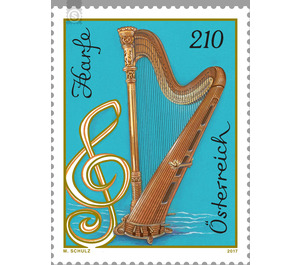Musical instruments - Austria / II. Republic of Austria 2017 - 210 Euro Cent
Theme: Art & Culture
| Country | Austria / II. Republic of Austria |
| Issue Date | 2017 |
| Face Value | 210.00 |
| Edition Issued | 150,000 |
| Perforation | 13¾ x 13¾ |
| Printing Type | Combination printing, offset stitch (Etch-Art by OeSD) |
| Stamp Type | Commemorative |
| Item Type | Stamp |
| Chronological Issue Number | 2663 |
| Chronological Chapter | OOS-OE2 |
| SID | 364637 |
| Dimensions | 42.00 x 32.00 |
| In 70 Wishlists | |
One of the largest and heaviest instruments in an orchestra is the harp, which is considered one of the plucked instruments. All harps, regardless of their design, have three main elements in common: the sound box, also called the body, the neck and the strings. The approximately 1.80-meter-high harp column is her backbone, so to speak, it forms a triangle with the body and the neck. The strings are parallel to the column. The neck is the curved upper part of the harp to which also the tuning pegs and turntables are attached, with which the harp is tuned. The body connects the neck with the foot of the harp's column, he creates the sound. There are also pedals in the foot to increase the sounds when playing. The harp is not only one of the largest, but also one of the oldest musical instruments of humanity. Illustrations of archery artefacts from the time of ancient Egypt, about 3000 BC, can be found mainly in tomb paintings. In Europe, there are traditions of harps from about the 8th century AD. Harps are universally applicable as solo instruments as well as in an orchestra or as a voice accompanist. A famous piece of music is Mozart's Double Concerto for Flute, Harp and Orchestra C major (KV 299). Also composers like Mahler, Debussy and Bartók wrote many pieces for orchestra and harp. In many countries, special forms of harps are played, such as in Latin America, where the harp plays a major role in traditional music. The Tiroler Volksharfe, also called Liederharfe, is a simple pedal harp that is very popular in alpine folk music.


